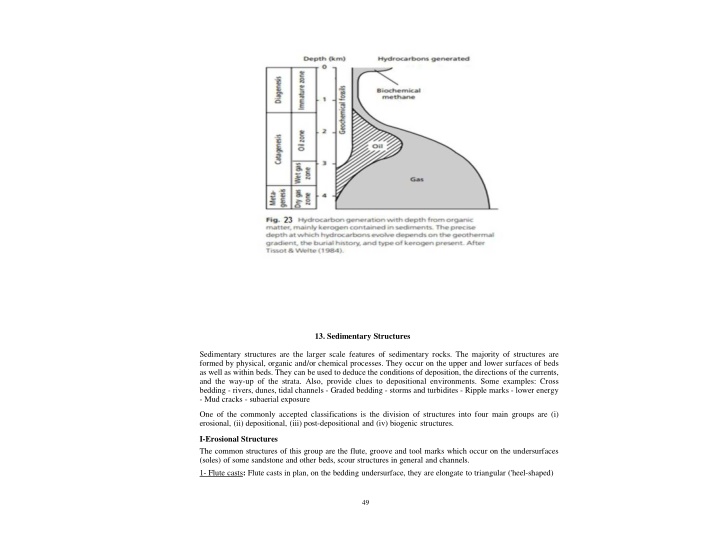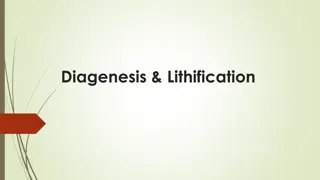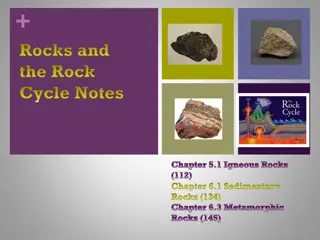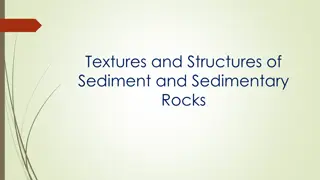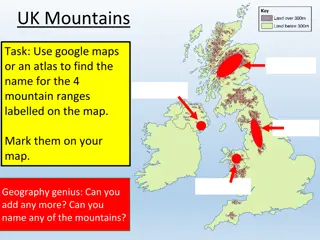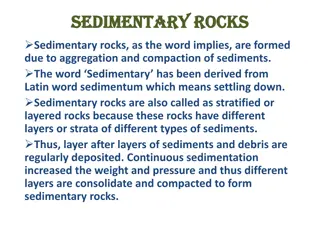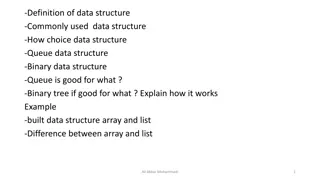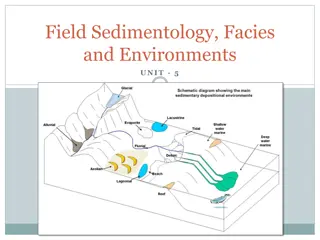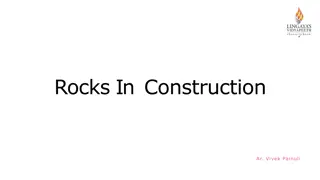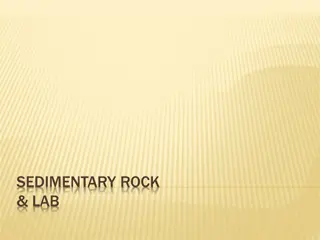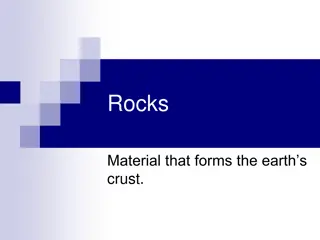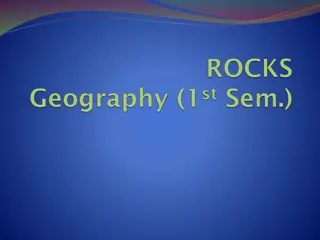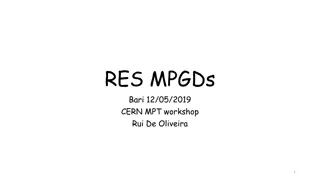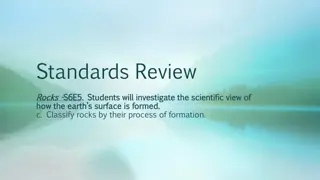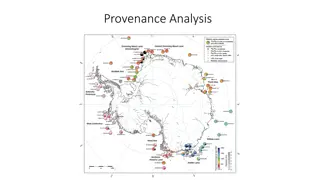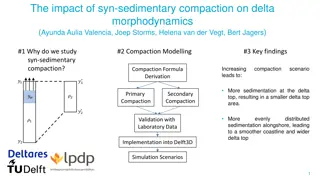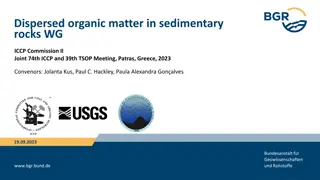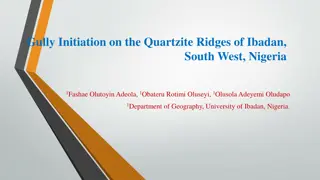Sedimentary Structures: Types and Significance
Sedimentary structures are features found in sedimentary rocks that provide valuable information about the conditions of deposition, current directions, and depositional environments. They can be erosional, depositional, post-depositional, or biogenic in nature, with examples including flute casts, groove casts, parting lineation, tool marks, scour marks, and channels. These structures play a crucial role in understanding the history and formation of sedimentary deposits.
Download Presentation

Please find below an Image/Link to download the presentation.
The content on the website is provided AS IS for your information and personal use only. It may not be sold, licensed, or shared on other websites without obtaining consent from the author.If you encounter any issues during the download, it is possible that the publisher has removed the file from their server.
You are allowed to download the files provided on this website for personal or commercial use, subject to the condition that they are used lawfully. All files are the property of their respective owners.
The content on the website is provided AS IS for your information and personal use only. It may not be sold, licensed, or shared on other websites without obtaining consent from the author.
E N D
Presentation Transcript
13. Sedimentary Structures Sedimentary structures are the larger scale features of sedimentary rocks. The majority of structures are formed by physical, organic and/or chemical processes. They occur on the upper and lower surfaces of beds as well as within beds. They can be used to deduce the conditions of deposition, the directions of the currents, and the way-up of the strata. Also, provide clues to depositional environments. Some examples: Cross bedding - rivers, dunes, tidal channels - Graded bedding - storms and turbidites - Ripple marks - lower energy - Mud cracks - subaerial exposure One of the commonly accepted classifications is the division of structures into four main groups are (i) erosional, (ii) depositional, (iii) post-depositional and (iv) biogenic structures. I-Erosional Structures The common structures of this group are the flute, groove and tool marks which occur on the undersurfaces (soles) of some sandstone and other beds, scour structures in general and channels. 1- Flute casts: Flute casts in plan, on the bedding undersurface, they are elongate to triangular ('heel-shaped) 49
with either a rounded or pointed up-stream end, flaring in a downstream direction. In section they are asymmetric, with the deeper part at the upstream end. Flute marks vary in length from millimetres to tens of centimetres. Flute marks are formed by eddies in currents and are typical of turbidite beds. Flute marks are reliable indicators of palaeocurrent direction; their orientation should be measured. Figure 24 Flute marks on undersurface of a siliciclastic turbidite bed. Current flow from left to right. Field of view 50 cm. Silurian. S.E. Scotland. 2-Groove casts: Groove casts are elongate ridges on bed undersurfaces, ranging in width from a few millimetres to several tens of centimetres. They may fade out laterally, after several metres, or persist across the exposure. Groove casts on a bed undering of grooves may be all parallel or they may show a variation of trend. Groove casts form through the infilling of grooves by objects (lumps of mud or wood, etc.) dragged along a current. They are common in the undersurfaces of turbidites, fluviatile and storm deposited sandstones. Groove casts indicate the trend of the current and their orientation should be measured. 50
Figure25 Groos-e marks on undersurface of siliciclastic turbidite. Field of view 4 m. Carboniferous. S.W. Eng!aiui. 3- Parting lineation: occurs on the surface of the laminae. It consists of very low ridges only a few grain diameters high and hollows. The lineation results from turblent eddies immediately adjancent to the sediment surface. 4- Tool marks:These form when objects being carried by a current come into occasional contact with the sediment surface. The marks are referred to as rod, roll, brush, bounce and skip marks, as appropriate, or simply as tool marks. An impression left by an object may be repeated several times, if it was saltating. Objects making the marks are commonly mud clasts, and fragments of animal and plant debris.As with flutes and grooves, tool marks are seen as casts on the soles of beds, particularly of turbidites. 5- Scour marks: These are erroded by strong currents. They are small scale structure, generally less than a metre across, occurring on the base of beds and within them. In plan they are usually elongated in the current direction. With increasing size, scours grad into channels. Typical features of scoured surfaces are cutting out of the underlying sediments, the truncation of the underlying laminae and the presence of coarser sedimentoverlying the scoured surface. The scoured surfaces are often, irregular, with some relief, but can be smooth. They often form during a single erosional event. 6- Channels: Channels are larger-scale structures, metres kilometers across, that are generally sites of sediment transport over long periods of time. Many channels are concave-up in cross-section and their fills form elongate (shoestring) sediment bodies when mapped in plan. As with scours, channels can be recognized by their cross- cutting relationship to underlying sediments. Channels are frequently infilled with coarser sediment than that below or adjacent, and there is often a basal conglomeratic layer. Cross-bedded sandstones infill many channels. Channels are present in sequences of many different environments, including fluviatile, deltaic, shallow subtidal-intertidal, and submarine fan. The orientation of the channel 51
structure indicates the direction of the palaeo-slope, important in palaeogeographic reconstructions. Bounce marks. The tool approaches the sediment surface at a low angle and immediately bounces back into the current. % Brush marks. The tool approaches ihe sediment surface at a very low angle, with the axis of the tool inclined upeurrent. and Is then Hted away by the current, producing a ridge of mud dowrtcurrent of the mark Prod marks. The tool reaches the sediment surface at a fairly high angle and is then lifted up and away by the current. 0 Roll narks. The tool rolls over the sediment surface, producing a continuous roll mark. E Skip marks. The tool travels downcurrent with a satiating movement, hitting the sediment surface at near regular intervals. Figure ?6 Postulated development in a cohesive mud bottom of (A) bounce marks, (B)brush marks, (C) prod marks, (D) roll marks, and(F) skip marks, which formed by tire action of tools mak ing contact with the bottom in various ways. These tool-formed depressions are subsequently filled with coarser sediment to produce positive-relief casks. (After Reineck, 1LE. and I. B. Singh, 1980, Depositional Sedimentary Environment?,2ndedn . Springer-Vertag, Berlin, Figs. 125,127, 129,132,131, p. 82, 83, reprinted by permission.) 52
Fig. 27 Showing channels with concave-up in cross-section and their fills. II- Depositional structures In this group are the familiar structures, bedding, lamination, cross-stratification, ripples and mudcracks. Depositional structure occur on he upper surface of beds and within them. In limestones addititional strructures are frequently present, including varios types of cavity, algal stromatolites, hardgrounds and tepees and subaerial solution (paleokarstic surfaces). 1- Stratification (bedding and lamination): The characteristic feature of sedimentary rocks is stratification. It is identified by changes in sediment composition, color, presence of fossils and/or grain size. This is produced by changes in the pattern of sedimentation (e.g. climate, sea level changes, tectonism, sediment supply). Bedding is generally defined as a sedimentary layering thicker than 1 cm. Finer scale layering, only a few millimeters thick, is termed lamination. Beds also vary in their shape and definition so that planar, wavy and curved types are recognized, and these may be parallel to each other, non-parallel or discontinuous. Bedding- plane surfaces may be smooth, undulating, rippled, sutured, etc., and represent long or short breaks in sedimentation. Bedding results from bed load. The term bedload describes particles in a flowing fluid (usually water) are transported along the bed by rolling, sliding, and/or saltating. Bed boundaries can be deformed by soft-sediment compaction and loading; the contacts between sandstones and underlying mudrocks are commonly affected in this way. Tectonic movements can also modify bed junctions. Bed thickness is an important and useful parameter to measure. With some current deposited sediment, such as turbidites and storm beds ( tempestites ), for example, bed thickness decreases in a down- current direction. In vertical succession, there may be a systematic upward decrease or increase in bed thickness, reflecting distance from the source area, or amount of uplift in the source area and sediment supply. 53
Lamination is formed largely by deposition from suspension or low-density turbidity currents, periodic precipitation of minerals such as calcite, halite or gypsum/anhydrite, and from the blooming of plankton in surface waters with subsequent deposition of organic matter. These finely laminations are deposited in protected quite environments such as lagoons and lakes and in relatively deepwater marine basins below the wave-base. Shale, is a rock that can be splitted into thin sheets (fissile) which may coincide, with concentration and alignment of clay minerals and tiny mica flakes. Tnblf S. Terminology pf bed tkictness. 1 in <U in 01 m .to mm Very ihinl) bedded very thickly bedded thickly bedded medium bedded thinly Ivddcd 10 mm thickly l imiLisilcd 3 mni thinly laminated 2- Graded beds: Graded bedding develops as a response to changes in flow conditions during sedimentation. Many different types of graded bedding have been described. These show grain-size changes from bottom to top. The most common is normal graded bedding where the coarsest particles at the bottom give way to finer particles higher up. Normal graded bedding often results through deposition from waning flows; which is typical of turbidity current and storm current deposits. Less commonly reverse (or inverse) grading is developed, where the grain size increases upwards. Graded bedding can be observed (and measured) in conglomerates with no difficulty and in sandstones with the aid of a handlens. Reverse grading can arise from an increasing strength of flow during sedimentation and backwash on beaches. Reverse grading can occur in the lowest parts of gravity sediment flow such as grain flow and debris flow deposits. C? C> <Z> O ^ OpOtt \: O OO C? ISSttai O o O Sv t; :! ! .! *7- y. 4rf. v "r*1- ungraded O O Qo Ooooo Oooo <OC o Q o " oo c? o o O Q O c > * r* f 54 o o c o o ^* O o o C?Q Oo OO (S53S> normal Figure 28 Different types of graded bedding 00 > Composite or multiple-graded bedding is where there are several graded units within one bed. Composite graded bedding can reflect pulses in the current. inverse
